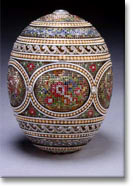by Nancy Gerlach, Fiery-Foods.com Food Editor Emeritus
|
|
Recipes in this Issue: Caribbean Crab-Stuffed Deviled Eggs Enchiladas Stuffed with Hard-Cooked Eggs (Papadzul) Mottai Kolambu (Egg Curry in a Coconut Gravy) Hot and Spicy Pickled Eggs Wilted Spinach with Bacon and Balsamic Dressing
|
(Editor’s Note: Nancy is not only a registered dietitian, she keeps chickens.
So the collision of her vocation and her avocation led to this article.)
It’s the time of year when the color of the New Mexico landscape changes from winter browns to the greens of spring. The forsythia and daffodils are blooming, fruit trees are flowering, and the desert winds have started to blow–sure signs that spring is here and Mother Nature is waking up. Spring is also the time of year when cute little bunnies take the credit for what the chickens produce—eggs to be dyed for Easter. But long before the egg became associated with the Christian holiday, it was an important part of the mythology, religion, and rites of many cultures.
The egg has played a predominant role in many creation stories. Phoenicians, for example, believed that an egg produced in the primeval waters split open to form heaven and earth. In ancient Egypt, there were two creation stories that related to eggs. In one, Geb, the great cackler, and Nut, the sky goddess, produced an egg which gave birth to the sky and earth and in the other, the egg itself was created from the sun and the moon. And in China, the belief is that the first man came from an egg dropped from heaven by Tien, the controlling power of the universe.
Throughout history, special powers have been attributed to eggs, including the ability to predict the future, bring good luck and guard against the bad, to cure ills both social and medical, and to guard against infertility and insure plentiful harvests. In Rome, Nero’s consort Livia used an egg to determine the gender of her unborn child. She kept an egg in the “warmth of her corsage” (cleavage), until it hatched. And when hatched, the sex of the chick would foretell the sex of the child. A male chick hatched, she gave birth to the Emperor Tiberius, and the old wive’s tale about an egg determining the sex of a child was born. On the other side of the world, Mayans would use an egg to break the spell of the evil eye. The ritual included waving an egg in front of the affected person, cracking it open and reading the yolk, and finally the contents were buried in a secret place.
The supposed power of the egg was not limited to living beings. Buildings have been blessed by egg concoctions smeared on them, eggs buried under them, as well as eggs mixed in the mortar holding them together. And the best one is that if you can find the secret of the philosopher’s egg, alchemists believed you could turn base metal into gold.
Coloring and exchanging eggs have been a part of spring festivals that celebrate the earth and sun’s rebirth from the winter’s darkness long before the Christian Easter. Ancient Greeks, Persians, Egyptians, and Chinese all have used dyed eggs, usually red, in their springtime rites. The significance of the egg has its roots in very early history and probably relates to this renewal for two reasons. First because you can actually see life being hatched from an egg, and secondly due to the lengthening of the days at this time of year and its affect on hens. The increase in sunlight causes hens to start laying after their winter dormancy period, and thus the cycle of birth begins again. With the advent of Christianity however, the egg came to represent the rebirth of man, not nature and the earth.
Over time, decorating eggs became more elaborate than just coloring them. In the middle ages, Edward I of England had four hundred and fifty eggs gold leafed to give as Easter gifts. And the intricate hand-decorated Ukrainian eggs are truly works of art. The most famous, and the most expensive eggs however, are those made by the goldsmith Peter Carl Fabergé in the 1880s. He was commissioned by the Russian Czar Alexander to create an Easter gift for this wife, the Empress Marie. The first egg he made opened to display a smaller golden egg, which opened to reveal a golden chicken and a jeweled replica of the Imperial crown. The Czarina was so delighted with the gift that the Czar ordered Fabergé to design a new egg every Easter. After the Czar’s death, his son Nicholas II continued the custom. Fifty-seven eggs were made over the same number of years and the most expensive one ever sold was the Winter Egg, which brought $5.6 million in 1994.
Eggs have been eaten and enjoyed for hundreds of years, but over the last few, they’s gotten a bad rap because of their cholesterol level. But if you love eggs, there is some good news. Modern testing equipment has determined that their cholesterol content is more in the range of 214-220 mg. rather than 274 mg. as previously thought. So it is possible to include eggs in a healthy diet and still keep within the recommended level of 300 mg. or less of cholesterol per day.
With just the right mix of essential amino acids needed by humans to build tissues, eggs contain the highest quality—and the most inexpensive—protein you can buy. Eggs also contain thirteen essential vitamins and minerals and are second only to mother’s milk for human nutrition.






